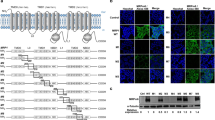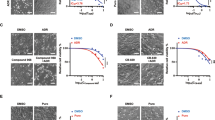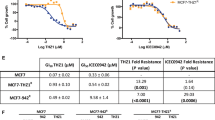Abstract
Multidrug resistance (MDR), caused by overexpression of either P-glycoprotein or the multidrug resistance-associated protein (MRP), is characterized by a decreased cellular drug accumulation due to an enhanced drug efflux. Many studies on cells overexpressing MRP and/or Pgp, have shown a concentration of the drug inside cytoplasmic acidic vesicles followed by an exocytotic process. In this study, we examined the effects of 7-chloro-4-nitrobenzo-2-oxa-1, 3-diazole or NBD (a H+-ATPase pump inhibitor), buthionine sulphoximine or BSO (an inhibitor of glutathione (GSH) biosynthesis) and verapamil or VPL (a calcium channel blocker) on the subcellular distribution of daunorubicin or DNR in K562 cells overexpressing MRP (K-H30) and Pgp (K-H300) and A549 cells overexpressing spontaneously MRP. Nucleo-cytoplasmic distribution of DNR was carried out using scanning confocal microspectrofluorometry. This technique allows determination of nuclear accumulation of anthracyclines. Our results show that nuclear accumulation of DNR in K-H30 and A549 cells was increased by NBD, BSO and VPL while in K-H300 cells, only VPL was able to increase nuclear accumulation of DNR. Similarly, NBD, BSO and VPL could reverse DNR resistance in K-H30 cells whereas, in K-H300 cells, only VPL increased the sensitivity of these cells. These data suggest a requirement for GSH in MRP-mediated resistance and suggest that even if vesicular sequestration can happen in cells overexpressing MRP and Pgp proteins, probably only the MRP protein is able to extrude the drug through intracellular vesicles and efflux. Finally, NBD and BSO might be a useful agents in facilitating discrimination between Pgp and MRP phenotypes and prognosis in patients.
This is a preview of subscription content, access via your institution
Access options
Subscribe to this journal
Receive 12 print issues and online access
$259.00 per year
only $21.58 per issue
Buy this article
- Purchase on Springer Link
- Instant access to full article PDF
Prices may be subject to local taxes which are calculated during checkout
Similar content being viewed by others
Author information
Authors and Affiliations
Rights and permissions
About this article
Cite this article
Benderra, Z., Morjani, H., Trussardi, A. et al. Characterization of H+-ATPase-dependent activity of multidrug resistance-associated protein in homoharringtonine-resistant human leukemic K562 cells. Leukemia 12, 1539–1544 (1998). https://doi.org/10.1038/sj.leu.2401166
Received:
Accepted:
Published:
Issue Date:
DOI: https://doi.org/10.1038/sj.leu.2401166



